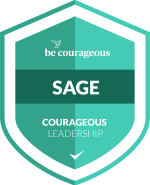Change = Opportunity
Exponential technological change, a highly-interconnected-yet-divided world, 8 billion people pushing up against planetary boundaries in climate, water, and the ability to produce and distribute food is, as one of our clients said, “Trying to operate in a VUCA-World-on-Steroids (Volatile-Uncertain-Complex-Ambiguous).”
But we don’t need to see all this anxiety-provoking change as negative. Change is the opportunity to create the world we want to live into. To create opportunity from change requires us to shift our perspective of the world and operate in fundamentally different ways as “Future-Ready Leaders.”
Thriving as a leader in the future
How we lead is a neurological process rooted in what we value. To thrive in the future, we have to believe that change and uncertainty can be a strategic advantage. We have to value staying in uncertainty and change, otherwise we will run from it. Being okay with change lifts us out of survivalism. As Future-Ready leaders, we need to move from a limiting mindset to an empowering one. Only then will we start to ascend to the results we want.
To become Future-Ready leaders, there are five facets of ourselves we need to master.
As you read the personas below, think about which qualities come naturally to you and which you need to develop to have the well-rounded traits of a Future-Ready leader.

NAVIGATOR / Psychological courage
Time Travelers:
Navigators use knowledge, imagination, and creativity to step into futures where they see opportunity. They figure out what they want their impact to be, and it is from imagined futures they envision what they must do today to get the future they want to create. They operate from a, “Where focus goes, energy flows” mindset and focus on intention rather than attention.
Vision Setters:
Navigators set the vision of the future for their organizations and teams to aim towards. e.g., “Imagine that driverless cars are commonplace, then what?” They understand there’s too much uncertainty to use a traditional planning approach, and instead to set ambitious goals to navigate one-step-at-a-time towards the future.
New Mental Model Seekers:
Navigators focus their energy towards the new mental models of the future. There will be new ways of looking at the world in the future, and how we live in it. Today, it’s not unusual to pick up a piece of glass (smartphone) and see someone on the other side of the world. Four hundred years ago, the same act would’ve had you burned at the stake as a witch.
Rule Breakers:
Navigators question today’s rules and beliefs. They ask the critical question of, “Why does it have to be that way?” They understand that with technology and interconnectedness, people can design a way around current rules and beliefs that restrict us, while still serving their core function. They are the Ubers of this world who ask questions like, “Why does a stranger have to equal danger?”
Systems Thinkers:
Navigators look for how systems will change and what that will mean for the future. They use tools like this Disruption Map, showing the changes to systems that autonomous transportation have had or will have.Time


TRANSFORMER / Spiritual courage
Architects of the Future:
Transformers challenge our beliefs on how we must think about things. They are masters of learning, and more importantly unlearning. They think big, bold and outside of the box, and they dare to chase a change worth fighting for.
Ace Adapters:
Transformers understand there is a critical risk of not being future-ready in a world of exponential technological change and critical planetary challenges. They face their fear of change by building a relationship with it and letting fear go, because adapting is less risky than maintaining the status quo.
Action Takers:
Transformers are action-takers for themselves, their teams, and organizations by removing learned biases, boundaries and behaviors on how to get to the envisioned future.
Co-Creationists:
Transformers operate from Joy’s Law, “No matter who you are, most of the smartest people work for someone else.” They enable and foster a co-creative approach and an ecosystem (internal and external) that can move quickly and solve complex problems. They actively look to expand the network that can help bring the vision to reality.
Learning-First Environment Builders:
Transformers create a work environment that maximizes learning over minimizing risk. They design the culture needed to encourage experimentation and engineer the processes to ensure teams have a disciplined and measured approach to learning quickly and cheaply to efficiently find the way forward.
Expertise Gap Bridgers:
Transformers ensure their team has the skills to creatively problem seek and solve, and to collaborate and make sure the team/organization has, or has access to, the expertise needed to build towards the envisioned future.
Antifragile Thinkers:
Transformers use antifragile approaches to ensure that the core of the business is safe, while at the same time taking bets on the future.
Speed of Change Engineers:
Transformers decentralize decision-making where it is a bottleneck to progress by enabling systems to be fluid, nimble and agile while also being directionally-aligned.

SAGE / Everyday courage
Larger Context Considerers:
Sages ask questions, starting with, “How should we think about this?” They seek new mental models of understanding. They actively seek diverse and contrary perspectives and intentionally ask different questions to understand the bigger context they, their team, and the company are operating in.
Decision-Making Guides:
Sages understand that at the accelerating pace of change, over-centralized control can be detrimental, so they look to decentralize decision-making and shift their role to a guide rather than a superior. They value influence over authority.
Growth Mindset Models:
Sages intentionally and authentically model the behaviors of continuous learning, unlearning and change. They’re candid about the difficulties they face with change, to enable others to overcome their fears, and courageously change their perspectives.
Advisors on Uncertain Futures:
Sages understand the path ahead is uncertain, and that we may not have a ready-made solution to every challenge, but we do have a process for inventing one or many solutions.

BUILDER / Physical Courage
Courage Creators:
Builders overcome the fears and emotional blockers to creativity and find the courage to lean in to bring their’s and their team’s gifts to the world.
Makers of the Meaningful:
Builders produce meaningful products, solutions and content for the world to create or inspire the change they want to make.
Big Creative Thinkers:
Builders encourage and actively choose to create a new way over defending the current solution, if that is what the future calls for.
Incremental Action Takers
Builders systematically work their way toward small, medium, and large goals, one manageable, but bold step at a time. They understand that path forward is a series of day-to-day progress, and are committed to day-to-day 365 days a year.
Foundation Layers:
Builders focus on laying down the base layers and foundations of tomorrow, today. They understand that even though the long-term, ambitious vision is not fully realizable at the moment, we can and must start today to build the footings needed for our longer term goals. They say, “What can we build today that gets us closer to our ambitious vision? Let’s build it.”
Doers:
Builders are active creative problem solvers and seekers, striving to help the team and organization get to every milestone to their envisioned future. Whether it’s in their job description or not.
While the Navigators are the Ubers of this world who ask questions like, “Why does a stranger have to equal danger?” The Builder develops tools, services or products to design around stranger = danger.

PROTECTOR / Moral Courage
Guardians:
Protectors protect their core values worth standing for. They understand what core values are needed for the future, and they intentionally model them. A protector’s behavior creates not only followers but collaborators who are also empowered to stand up for what matters. To ensure their energy is focussed on what matters, they protect their team’s time and space from being overwhelmed by the present.
Morality Bearers:
It can be the wild west of experimenting on the edge, and that space needs an active protector to help build an ethical future. Protectors focus their courage and energy at ensuring the best possible future for all.
Providers of Air cover:
Protectors provide the “air cover” for the team/organization to be constantly experimenting and learning as they work their way to realizing the vision.
Expectation Gap Managers:
Protectors understand that the path to an exponential future is different from the path of short-term outcomes. They understand laying the foundation of tomorrow can feel deceptively slow, and the rewards of exponential growth are heavily weighted on the back-end. They protect the project and the team from short-term thinking, and the wish from the rest of the organization and the market for immediate results.
Progress Rewarders:
Builders establish new metrics of success that rewards active learning and takes the risk of innovation off the team and individual, and onto the company.
Which courage persona do you most identify with now?
All of us have all of these courage personas inside us at all times. We need them all at one time or another in our leadership careers. It’s a matter of learning, which one serves which situation? To be the most well-rounded Future-Ready leader, hone your skills in areas that don’t come as naturally. Mastering all five will make you a Future-Ready leader ready for anything.
It’s time to start building your Future-Ready leadership foundation. Growth always starts with asking the right types of questions. A good question sparks curiosity and discovery. The answers that reveal themselves are guides to taking the right actions and to asking the next set of questions.
We have built a Future-Ready flywheel that asks five archetypes questions that build on one another to create momentum for you to take your leadership to the next level.
If you or your team need assistance with Future-Ready Leadership training, we are here to help!
Co-Authors:
Shannon Guyton and Kyle Hermans

Future Ready Leadership Worksheets
Develop all 5 personas of courage to become a Future-Ready Leader.


